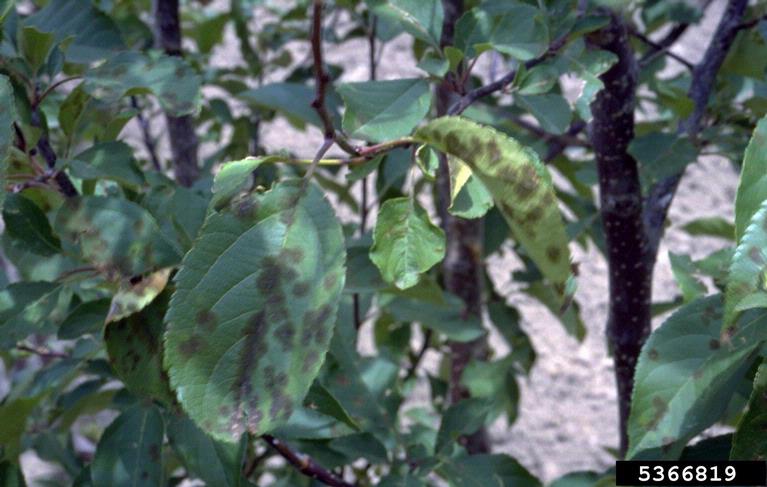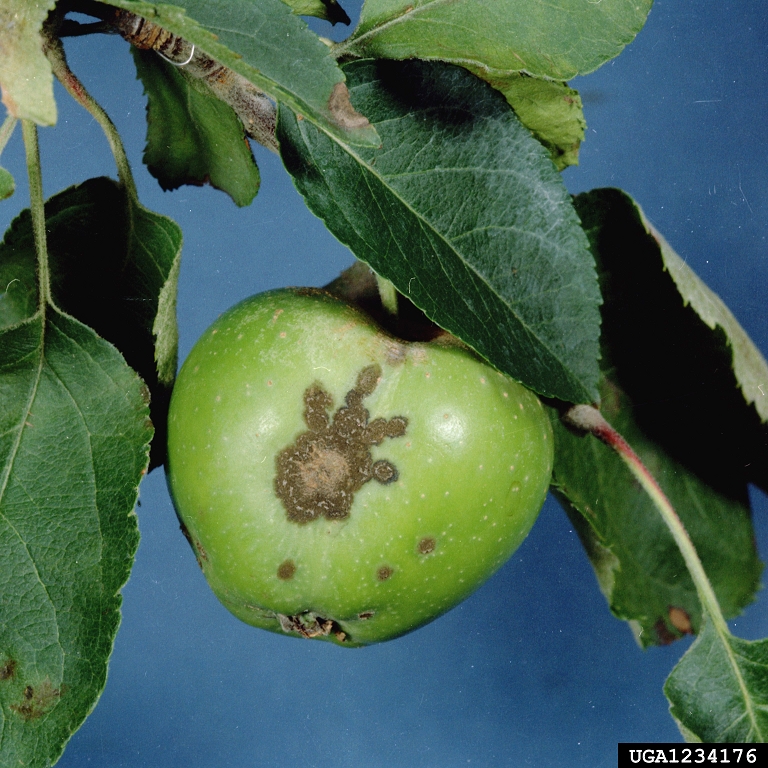
Apple scab, caused by the fungusVenturia inaequalis, is one of the most important diseases of apples and crabapples in Nebraska. It causes decreased yield, lower fruit quality, thin tree canopies and reduced tree vigor. Nearly every year, the disease defoliates susceptible varieties of ornamental crabapple.
Fungicide control of apple scab on trees with a history of heavy infestation, begins at bud break, which is only a few weeks away.
 Symptoms
Symptoms
Apple scab fungi overwinter on infected leaves and fruits, and develop fruiting bodies on those dead materials in late winter and early spring. Mature fungal spores are released into the air during periods of spring rain, and blown to nearby trees. Peak spore dispersal usually coincides with bloom. Spores that land on a leaf or fruit, and come in contact with water germinate and cause infection. So disease development is favored by wet, humid weather that prevails from late April through June.
The first symptoms appear on the undersides of leaves as olive to greenish-black spots with indefinite, feathery margins. With time the lesions darken and become evident on the leaf's upper surface. Leaves with large numbers of leaf spots may become distorted, and drop prematurely from the tree. Lesions on the apples are also olive to greenish-black, becoming cracked or "scabby" as the fruits enlarge. Heavily infected fruits may become misshapen. Although unsightly, the fruit lesions are superficial and unblemished portions of the fruit are still safe to eat.
Control Strategies
There are several approaches to managing apple scab, each of which offers some degree of success when used individually. The best long-term management, however, involves integrating multiple tactics, including the use of resistant varieties, sanitation, and chemical control.
Plant resistant apple and crabapple varieties. The following apple varieties have shown resistance to the apple scab fungus: Easy-Gro, Enterprise, Freedom, Gold Rush, Jonafree, Liberty, Mad-free, Prima, Pristine, and Redfree. However, in years with heavy disease pressure even resistant apply varieties may still require occasional spraying to totally eliminate apple scab damage to the fruits. Resistant crabapple varieties include: Bob White, Calocarpa, David, Jackii, Prairifire, Red Splendor, Sargent and Sugar Tyme.
Sanitation includes raking up and disposing of infected leaves and fruits in fall or early spring before trees begin to leaf out. If you haven't done this already, and there are still last year's old leaves and fruits laying on the ground beneath your tree, take time now to clean them up. Either destroy or discard heavily infected leaves.
During the growing season, avoid wetting the leaves of apple and crabapple trees with lawn sprinklers.
Effective control of apple scab using chemical fungicides depends on the timeliness and repetition of applications, and the degree of coverage obtained on both the upper and lower leaf surfaces. Begin applications in spring at bud break and repeat applications as directed by the fungicide label. For a complete spray schedule for home orchardists, including a list of appropriate fungicides, refer to the University of Missouri's publication "Fruit Spray Schedules for the Homeowner". Always read and follow all label directions and precautions.
Image above - apple scab lesions on the fruit. Image by Clemson University - USDA Cooperative Extension Slide Series, Bugwood.org.